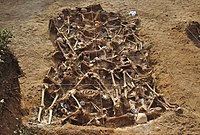قتل جماعي

القتل الجماعي، على النحو الذي حدده عالم الإبادة الجماعية إرفين ستوب، هو «قتل أعضاء من جماعة دون نية للقضاء على المجموعة بأكملها أو قتل أعداد كبيرة من الناس دون تعريف دقيق لعضوية المجموعة».[1] [3] يستخدم هذا المصطلح عدد من علماء الإبادة الجماعية لأن مصطلح «الإبادة الجماعية» (تعريفه الدقيق) لا يغطي أحداث القتل الجماعي عندما لا يتم استهداف مجموعة عرقية أو دينية محددة، وعندما لا يكون الجناة مقصودين للقضاء على المجموعة بأكملها أو جزء كبير منها. تناقش هذه المقالة بشكل أساسي النماذج المختلفة التي يستخدمها علماء الإبادة الجماعية لشرح وتوقع بداية أحداث القتل الجماعي.
المصطلح
[عدل]وفقًا لـ Weiss-Wendt، فإن أي محاولات لتطوير مصطلحات مقبولة عالميًا تصف عمليات القتل الجماعي لغير المقاتلين كانت فاشلة تمامًا [4] فيما يلي قائمة بالمصطلحات التي يستخدمها علماء الإبادة الجماعية لوصف عمليات القتل الجماعي.
الطرد ضد القتل الجماعي القسري
[عدل]يرى بينجامين فالنتينو دوافع الحاكم كعامل رئيسي يفسر بداية عمليات القتل الجماعي، يحدد فئتين رئيسيتين من عمليات القتل الجماعي، وعمليات القتل الجماعي الطاردة والقتل الجماعي القسري.[5] شملت الفئة الأولى التطهير العرقي، والقتل الذي يصاحب الإصلاحات الزراعية في بعض الولايات بقيادة الشيوعيين، والقتل الجماعي خلال التوسع الاستعماري، وما إلى ذلك. تشمل الفئة الثانية عمليات القتل الجماعي خلال حرب العصابات المضادة، وعمليات القتل خلال الفتوحات الإمبريالية لمحور المحور خلال الحرب العالمية الثانية، إلخ. على الرغم من أن فالنتينو لا يعتبر الأيديولوجية أو نوع النظام عاملاً مهمًا يفسر عمليات القتل الجماعي، [6] أنه يحدد القتل الجماعي في ظل الأنظمة الشيوعية كنوع فرعي من عمليات القتل الجماعي الطاردة، والتي تعتبر من مضاعفات النظرية الأصلية التي يستند إليها كتابه.[7]
المراجع
[عدل]- ^ Staub، Ervin (1989). The Roots of Evil: The Origins of Genocide and Other Group Violence. Cambridge University Press. ص. 8. ISBN:978-0-521-42214-7. مؤرشف من الأصل في 2020-04-06.
- ^ Staub، Ervin (2011). Overcoming Evil: Genocide, Violent Conflict, and Terrorism. Oxford University Press. ص. 100. ISBN:978-0-195-38204-4. مؤرشف من الأصل في 2020-04-06.
- ^ "In contrast to genocide, I see mass killing as 'killing (or in other ways destroying) members of a group without the intention to eliminate the whole group, or killing large numbers of people' without a focus on group membership."[2]
- ^ Weiss-Wendt A. (2008) Problems in Comparative Genocide Scholarship. In: Stone D. (eds) The Historiography of Genocide. Palgrave Macmillan, London. DOI https://doi.org/10.1057/9780230297) "There is barely any other field of study that enjoys so little consensus on defining principles such as definition of genocide, typology, application of a comparative method, and timeframe. Considering that scholars have always put stress on prevention of genocide, comparative genocide studies have been a failure. Paradoxically, nobody has attempted so far to assess the field of comparative genocide studies as a whole. This is one of the reasons why those who define themselves as genocide scholars have not been able to detect the situation of crisis." نسخة محفوظة 10 سبتمبر 2018 على موقع واي باك مشين.
- ^ Valentino (2005) Final solutions p. 70.
- ^ Scott Straus. Review: Second-Generation Comparative Research on Genocide. Reviewed Work(s): Genocide in the Age of the Nation State by Mark Levene; The Dark Sideof Democracy: Explaining Ethnic Cleansing by Michael Mann; The Killing Trap: Genocide in the Twentieth Century by Manus I. Midlarsky; Purifier et détruire: Usages politiques desmassacres et génocides by Jacques Sémelin; Final Solutions: Mass Killing and Genocide in the Twentieth Century by Benjamin A. Valentino; A Century of Genocide: Utopias of Raceand Nation by Eric D. Weitz. World Politics, Vol. 59, No. 3 (Apr., 2007), pp. 476-501. Published by: Cambridge University Press. Stable URL:
- ^ Wayman، FW؛ Tago، A (2009). "Explaining the onset of mass killing, 1949–87". Journal of Peace Research Online. ج. 47: 1–17. DOI:10.1177/0022343309342944.
| قتل جماعي في المشاريع الشقيقة: | |
| |
Text is available under the CC BY-SA 4.0 license; additional terms may apply.
Images, videos and audio are available under their respective licenses.
